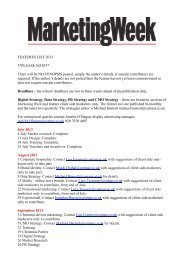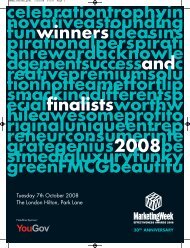Interactive Seven 2009 Supplement - Marketing Week
Interactive Seven 2009 Supplement - Marketing Week
Interactive Seven 2009 Supplement - Marketing Week
You also want an ePaper? Increase the reach of your titles
YUMPU automatically turns print PDFs into web optimized ePapers that Google loves.
MWIB_260209_p045 19/2/09 17:55 Page 45<br />
INTERACTIVE AD NETWORKS<br />
Under the spotlight<br />
Online ad networks may have fallen short of expectations, but they<br />
continue to thrive. However, fierce competition and strict budgets<br />
mean they must now be more accountable than ever. By Steve Hemsley<br />
This time last year, digital marketing experts<br />
were predicting great things for online ad<br />
networks. Research firm E-consultancy<br />
reported that media spend through these<br />
vehicles had doubled between 2006 and 2007 from<br />
£120m to £240m.<br />
This prompted it to forecast 60% growth for<br />
last year to an estimated £385m. However, following<br />
a strong first half, revenues dipped significantly<br />
in the final few months. E-consultancy has yet to<br />
confirm the final figures, but growth was probably<br />
nearer 30%.<br />
Although this remains a relatively healthy sector<br />
– the IAB claims ad networks take about 40%<br />
of online ad spend – this has become a fiercely<br />
competitive marketplace. There are about 80 suppliers<br />
offering to connect advertisers with websites,<br />
blogs, RSS feeds and emails on which to promote<br />
their wares. In fact, the large media owners have<br />
become used to asking these networks to sell their<br />
remaining inventory.<br />
Thanks to the evolution of behavioural targeting<br />
technology, the best networks have started to<br />
differentiate themselves. It means advertisers can<br />
target specific audiences more effectively, and marketers<br />
can partner with networks that really understand<br />
their specific industry sector.<br />
E-consultancy head of research Linus Gregoriadis<br />
expects some ad networks to “go under” this<br />
year and to see plenty of consolidation. The network<br />
Adrevenue went into administration in<br />
December after it failed to find a buyer. “Online is<br />
still very measurable and is more protected than<br />
other media because it is easier to track. But things<br />
are changing,” says Gregoriadis. “Ad networks will<br />
only survive if they have strong media properties.”<br />
With marketers being asked to question every<br />
penny they spend, the old negative arguments<br />
around using ad networks are raising their head<br />
again. Many advertisers have questioned the real<br />
value of unsold inventory. Others still fear their<br />
brand will appear on illegal or dubious sites, especially<br />
through “blind networks”, where marketers<br />
lose control over where their ads will run. The ad<br />
networks are also worried they will lose revenue<br />
to the paid search companies as advertisers chase<br />
responses to boost short-term sales.<br />
“In these difficult times, advertisers need tangible<br />
returns. With paid search and the clever use<br />
of key words, people will come to the most relevant<br />
pages on a website, so they are more likely to buy<br />
something,” says Rob Pierre, managing director of<br />
paid search company Jellyfish. “I would have<br />
Apprehensive: Some advertisers still fear their<br />
ads might appear alongside dubious content<br />
thought more ad networks would have moved to a<br />
cost-per-acquisition model.”<br />
Not surprisingly, the ad networks are fighting<br />
back. Research by independent ad network Specific<br />
Media suggests that paid and organic searches and<br />
clicks are influenced by online display ads. A 12-<br />
month study of its clients, using data gathered from<br />
the respected comScore Ad Effectiveness system,<br />
claims effective advertising can lift search queries<br />
by as much as 155%. The greatest impact was in<br />
travel and tourism, where exposure to display ads<br />
boosted queries by 274%. There was also significant<br />
growth in healthcare (260%), personal finance<br />
(206%), automotive (144%) and retail (69%).<br />
“Ad networks provide technology to discover<br />
surfers’ intentions and maintain relationships with<br />
websites on which ads can be served,” says Specific<br />
Media international managing director Colin<br />
Petrie-Norris. “We believe display advertising<br />
drives search, while in the past year the profile of<br />
the behavioural targeting used by ad networks has<br />
helped clients increase their yield and get better<br />
consumer insight.”<br />
Increased accountability<br />
Ad networks insist they make a marketer’s spend<br />
more accountable, especially if the network really<br />
understands the client’s industry. The network can<br />
tell the advertiser, using behavioural targeting,<br />
which websites a potential lead or influential decision-maker<br />
would visit, and which content they<br />
would read.<br />
It is always important to ask any network operator<br />
why and how its data will deliver the results<br />
you want, and to find out if it has any case studies<br />
specific to your industry or business. Marketers<br />
should always share information about their objectives.<br />
An ad network can make the mistake of thinking<br />
a client has just one objective, when it has<br />
different aims for its various brands and products.<br />
The digital media agency BLM Quantum, part<br />
of Havas/Arena BLM, even has a clients’ charter<br />
to ensure it gets the best service from ad networks.<br />
“We monitor everything when investing clients’<br />
money,” says managing director Dan Clays. “We ask<br />
questions about frequency, what content filters are<br />
in place so ads do not appear next to inappropriate<br />
content and, if we are using multiple networks, how<br />
to avoid any duplication.”<br />
When deciding how many networks to work<br />
with, Clays recommends choosing companies with<br />
effective optimisation technology to manage a campaign<br />
effectively. This would mean that under- performing<br />
websites are removed, for example.<br />
Marketers should also demand transparent reporting<br />
on where exactly their ads have appeared.<br />
The Internet Advertising Sales House (IASH)<br />
was set up in 2005 by ad network owners to encourage<br />
best practice, and it is keen to show it has teeth.<br />
It’s a year since it introduced random audits for<br />
members and, in July, it suspended an unnamed<br />
member for breaching its code of practice, which<br />
includes a ban on adverts appearing on “barred<br />
content” websites, such as those featuring indecent<br />
or hate content.<br />
The 16 members to pass the audit were Ad2One,<br />
ad pepper media, Adconion UK, Addvantage Media,<br />
Advertising.com, Consilium Media, dgmDisplay,<br />
DrivePM UK, eType, GMW Media, Glam Media UK,<br />
Specific Media UK, Tacoda UK, Unanimis Consulting,<br />
ValueClick Media UK and Yahoo! Network.<br />
IASH’s interim chairman is Richard Sharp,<br />
managing director of ValueClick Media. He accepts<br />
that marketers can still feel uneasy about ad networks<br />
because of fears about where ads will appear,<br />
but insists the IASH code is helping to reassure<br />
them. He also maintains there will be more costper-acquisition<br />
measurement in <strong>2009</strong>.<br />
One emerging area which is helping brands<br />
with international and regional campaigns is<br />
the mobile ad networks market. The technology<br />
exists to track responses to specific campaigns<br />
by measuring click-through rates and detailed<br />
analytics of the pages browsed. However, the high<br />
cost of mobile internet in the UK and the domination<br />
of banner ads, rather than more creative<br />
options, is holding the market back, says KF Lai,<br />
chief executive officer of Buzzcity, which runs a<br />
mobile ad network.<br />
Despite the uncertainty, it is likely the growth<br />
in ad networks will still outstrip the overall<br />
digital display advertising market in <strong>2009</strong>, fuelled<br />
by the emergence of more web publisherdriven<br />
networks and better regulation to ease<br />
advertisers’ fears. <br />
<strong>Marketing</strong> <strong>Week</strong> <strong>Interactive</strong> 45








